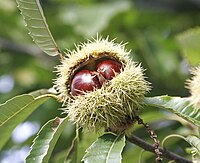
Photo from wikipedia
The European chestnut (Castanea sativa Mill.), is an environmentally and economically important species in Europe, mainly for fruit production. The chestnut fruit is well-known for its nutritional properties, namely its… Click to show full abstract
The European chestnut (Castanea sativa Mill.), is an environmentally and economically important species in Europe, mainly for fruit production. The chestnut fruit is well-known for its nutritional properties, namely its high concentration of carbohydrates (starch) and its low-fat content, as well as being one of the few fruits that do not contain gluten. Due to its chemical and nutritional characteristics beneficial to health, the sweet chestnut is a food recommended at different levels. The biochemistry of the mouth and nose of a human being is very complex. However, understanding the different interactions between the biochemistry of our sensory organs and food helps us to comprehend certain concepts, such as flavor and how it is involved in the sensory evaluation of the chestnuts. For the selection of high-quality products, it is necessary to develop reliable methods both from a qualitative and sensory point of view, and chestnut is a fruit with unique sensory characteristics that can be used in various gastronomic dishes, from main courses to desserts.
Journal Title: Foods
Year Published: 2022
Link to full text (if available)
Share on Social Media: Sign Up to like & get
recommendations!